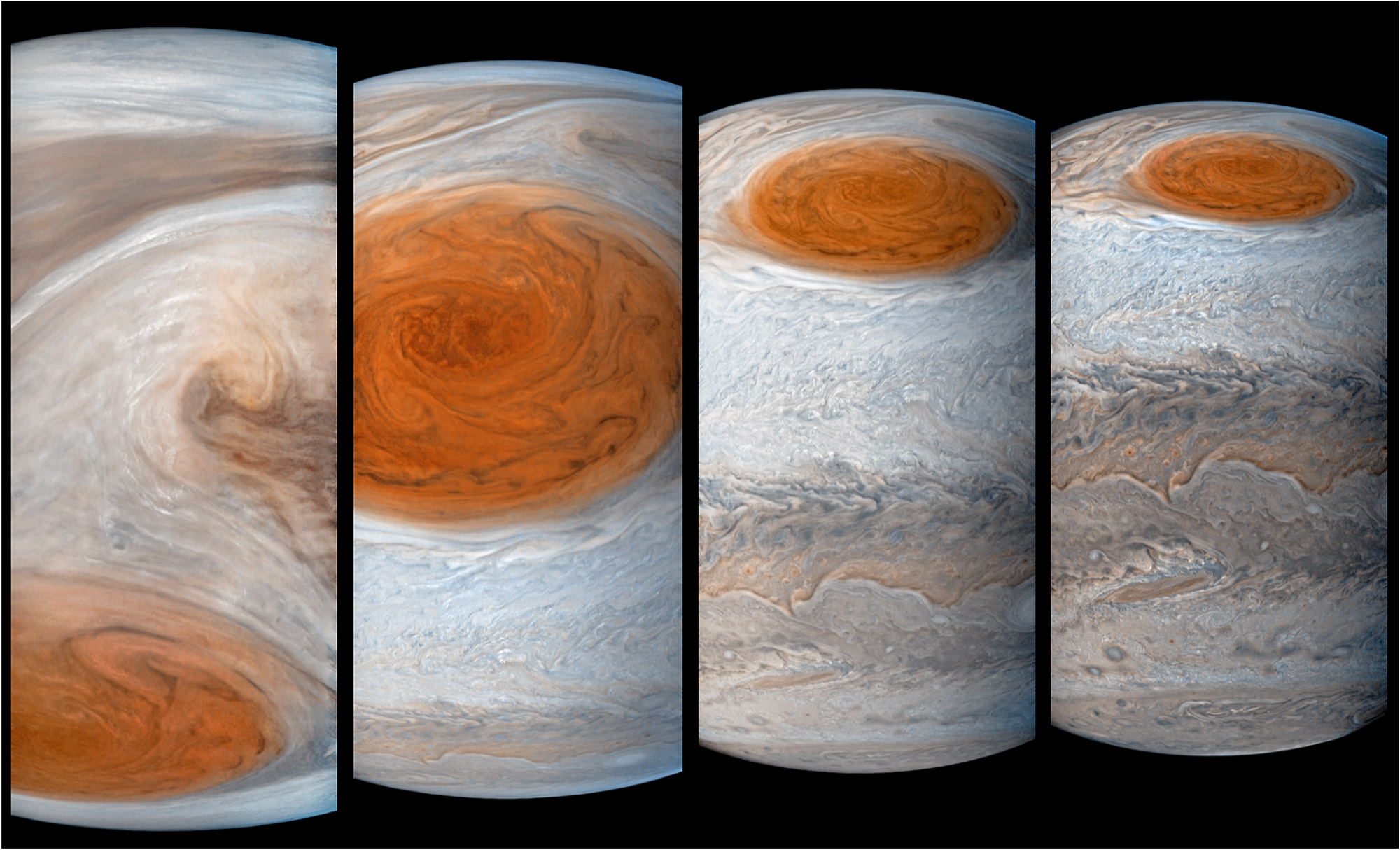

JunoCam captured these images of the Great Red Spot during the July 2017 fly-by of Jupiter. The composite images provide a richly-detailed look at the storm. Image: Sánchez-Lavega et al. 2018; composed by G. Eichstadt and J. Cowart
Jupiter’s Great Red Spot – the largest and most powerful of all the storms in the solar system – has been churning for hundred of years. Recently dozens of smaller storms have slammed into the Red Spot. Those smaller storms only caused superficial damage – and may have ended up feeding the beast itself.
While astronomers suspect that Galileo himself spotted the Great Red Spot on Jupiter, it wasn’t until the 1800’s the continuous observations confirmed that it was a single, long-running storm in the atmosphere of our solar system’s largest planet.
That storm is truly enormous. It’s an anti-cyclone, a center of high pressure surrounded by low-pressure atmosphere, that has been churning for centuries. It currently stretches over 15,000 kilometers across. That’s more than twice the width of our own planet Earth.
Strangely, the storm has been steadily shrinking over the decades. In the mid-1800’s, the Red Spot was over 40,000 kilometers across. Astronomers aren’t sure why it’s shrinking, and how long it might last.
But the Great Red Spot is not alone. Jupiter hosts innumerable smaller storms in its upper atmosphere (although “smaller” here still means half the size of Earth). Occasionally one or two of these storms will collide with the Great Red Spot. But starting in 2019, the Spot has been struck by over two dozen smaller storms every year.
And astronomers got a front-row seat to the action, thanks to NASA’s Juno spacecraft, currently in orbit around Saturn.
With each strike, the smaller storm appears to do considerable damage to the spot, tearing off streamers of the massive cyclone. But further analysis, recently published in the Journal of Geophysical Research: Planets, shows that the damage is only skin-deep. Indeed, instead of dismantling the Great Spot, the smaller storms feed it.
It appears that the damage to the Great Red Spot only goes down a few kilometers, while deeper in the atmosphere the Red Spot gains energy from the encounter.
“The intense vorticity of the [Great Red Spot], together with its larger size and depth compared to the interacting vortices, guarantees its long lifetime,” said Agustín Sánchez-Lavega, a professor of applied physics at the Basque Country University in Bilbao, Spain, and lead author of the new paper. As the larger storm absorbs these smaller storms, it “gains energy at the expense of their rotation energy.”
Perhaps without the collisions the Great Red Spot may have faded away decades ago. With the continual energy input, the great storm may survive for centuries to come.
“The ingestion of [anticyclones] is not necessarily destructive; it can increase the GRS rotation speed, and perhaps over a longer period, maintain it in a steady state,” Sánchez-Lavega said.
On December 27th, 2024, the Chilean station of the Asteroid Terrestrial-impact Last Alert System (ATLAS)…
On December 3rd, 2018, NASA's Origins, Spectral Interpretation, Resource Identification, and Security-Regolith Explorer (OSIRIS-REx) successfully…
The Andromeda Galaxy, our nearest large neighbour, has 36 identified dwarf galaxies. The Hubble telescope…
Rogue planetary-mass objects, also known as free-floating planets (FFPs) drift through space alone, unbound to…
The effects of Climate Change on Earth's living systems have led to a shift in…
Our Milky Way Galaxy is rich in dark matter. The problem is, we can't see…